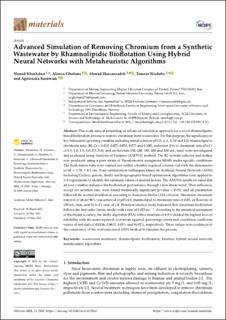| dc.description.abstract | This work aims at presenting an advanced simulation approach for a novel rhamnolipidic-based bioflotation process to remove chromium from wastewater. For this purpose, the significance of key influential operating variables including initial solution pH (2, 4, 6, 8, 10 and 12), rhamnolipid to chromium ratio (RL:Cr = 0.010, 0.025, 0.050, 0.075 and 0.100), reductant (Fe) to chromium ratio (Fe:Cr of 0.5, 1.0, 1.5, 2.0, 2.5, 3.0), and air flowrate (50, 100, 150, 200 and 250 mL/min) were investigated and evaluated using Analysis of Variance (ANOVA) method. The RL as both collector and frother was produced using a pure strain of Pseudomonas aeruginosa MA01 under specific conditions. The bioflotation tests were carried out within a bubbly regimed column cell with the dimensions of 60 × 5.70 × 0.1 cm. Four optimization techniques based on Artificial Neural Network (ANN) including Cuckoo, genetic, firefly and biogeography-based optimization algorithms were applied to 113 experiments to identify the optimum values of studied factors. The ANOVA results revealed that all four variables influence the bioflotation performance through a non-linear trend. Their influences, except for aeration rate, were found statistically significant (p-value < 0.05), and all parameters followed the normal distribution according to Anderson-Darlin (AD) criterion. Maximum chromium removal of about 98% was achieved at pH of 6, rhamnolipid to chromium ratio of 0.05, air flowrate of 150 mL/min, and Fe to Cr ratio of 1.0. Flotation kinetics study indicated that chromium bioflotation follows the first-order kinetic model with a rate of 0.023 sec−1. According to the statistical assessment of the model accuracy, the firefly algorithm (FFA) with a structure of 4-9-1 yielded the highest level of reliability with the mean squared, root mean squared, percentage errors and correlation coefficient values of test-data of 0.0038, 0.0617, 3.08% and 96.92%, respectively. These values were evidences of the consistency of the well-structured ANN method to simulate the process. | en_US |

